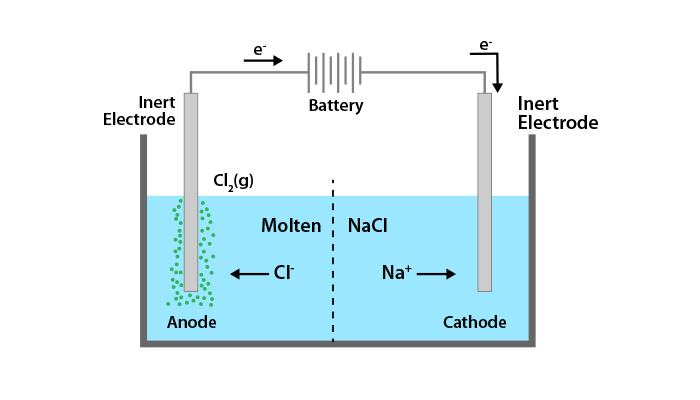
Electrolytic Cell - Definition, Diagram, Working and Applications
Nov 07, 2022, 16:45 IST
An electrolytic cell is a electrochemical device that uses the electrical energy to facilitate a non-spontaneous redox reaction . Electrolytic cells are generally electrochemical cells used to electrolyze the certain compounds. For example, water is subjected to electrolysis (using an electrolytic cell) to produce oxygen and hydrogen gas. This is done by the flow of electrons (into the reaction medium) to overcome the activation energy barrier of a non-spontaneous redox reaction.
The three components of electrolytic cells are-
- Cathode ( that is negatively charged for an electrolytic cell)
- Anode ( that is positively charged for an electrolytic cells)
- Electrolyte
An electrolyte provides the medium for the exchange of an electrons between both the cathode and the anode that is commonly used electrolytes in the electrolytic cells that include water (containing dissolved ions) and molten sodium chloride.
| Table of Content |
Difference Between Galvanic Cells and Electrolytic Cells
| Galvanic Cell (or Voltaic Cell) | Electrolytic Cell |
| It converts chemical energy into an electrical energy | It converts electrical energy into chemical energy |
| It contains negatively charged anodes and positively charged cathodes | It contains positively charged anode and negatively charged cathode |
| Feature spontaneous cell reactions | Feature non-spontaneous cell reactions |
Working and Diagram of an Electrolytic Cell
Molten sodium chloride (NaCl) can be applied to the electrolysis with the help of an electrolytic cell, as mentioned below.

Here, two inert electrodes are immersed in the molten sodium chloride (that contains dissociated Na + cations and Cl – anions). When an electric current passes into the circuit, the cathode becomes rich in a electrons and then develops the negative charge. The positively charged sodium cations are attracted toward the negatively charged cathode. This results in the formation of sodium metal at the cathode.
At the same time, a chlorine atoms are attracted towards the positively charged cathode. This results in the formation of the chlorine gas (Cl 2 ) at the anode (that is accompanied by the release of 2 electrons, thus completing the circuit). The associated chemical equations and overall cellular reaction are given below.
- Reaction at Cathode: [Na + + e – → Na] x 2
- Reaction at Anode: 2Cl – → Cl 2 + 2e –
- Cell Reaction: 2NaCl → 2Na + Cl 2
Thus, NaCl can be subjected to the electrolysis in an electrolytic cell to generate the metallic sodium and chlorine gas as the products.
Applications of Electrolytic Cells
- The primary use of electrolytic cells is for producing oxygen gas and hydrogen gas from water.
- They are also used to extract aluminum from bauxite.
- Another application of electrolytic cells is in electroplating, which is the process of forming a thin protective layer of a specific metal on the surface of another metal.
- Electrorefining of many non-ferrous metals is carried out using electrolytic cells.
- Such electrochemical cells are also used in electrolytic recovery processes.
- It may be noted that the industrial production of high-purity copper, high-purity zinc, and high-purity aluminum is almost always done through electrolytic cells.
Frequently Asked Questions (FAQs)
Q1. Is E cell positive in electrolytic cell?
Ans. E cell is negative for electrolytic cell.
Q2. How do electrolytic cells work?
Ans. When the external electric current flows into the cathode of an electrolytic cell, the resulting negative charge will attracts the dissociated positive ions present in an electrolyte. This results in the deposition of an positively charged ions into the cathode. Therefore, the negatively charged ions flow towards the anode, that is positively charged.
Q3. What are the uses of electrolytic cells?
Ans. Electrolytic cells can be used to produce the oxygen gas and the hydrogen gas from the water by subjecting it to an electrolysis. These devices can be used to obtain the chlorine gas and the metallic sodium from the aqueous solutions of the sodium chloride (common salt).
Q4. Is E cell always positive?
Ans. Ecell is always positive in a galvanic cell because the anode always has a negative E and the cathode always has a positive E.
Q5. What is the value of E cathode?
Ans. E°reduction = E°cathode = +0.340 V




